@Salve1412 :
Generally the mod+signed OFA NVMe driver v1.5.0.0 should support all NVMe Controllers from every NVMe SSD.
This is the way I install it while running the latest version of Win10 (provided, that the Win-RAID CA Certificate has been already imported):
1. Open the Device Manager and expand the "Storage Controllers" section.
2. Right-click onto the listed NVMe Controller (whichever name it currently has) and choose the options "Update Driver" > "Browse my computer…".
3. Hit the "Search…" button and navigate to the folder, which contains the desired driver.
4. Hit "OK" and the driver will be installed automaticly.
Try it!
@Fernando :
Thank you for the answer. That is exactly the procedure I followed and unfortunately, as I wrote before, it doesn’t work: the system hangs at the motherboard OEM Logo after a spin of the OS loading circle. Fast Boot is disabled both in BIOS and in Windows, Hibernation is disabled in the latter. I tried the drivers even after reinstalling the OS but with no luck: I guess there might be some sort of incompatibility after all. Did i correctly import the WIN-RAID CA Certificate according to the steps I reported in my previous post?
Hey Fernando.I remember a while back either you or someone said the reason windows hangs with fast boot enabled was something to do with the operating system. When I first ran the OFA NVMe driver v1.5.0.0 indeed it hung at the boot logo spinning wheel. For me that was in the spring and I could not remember which version of Windows 10 Pro I was on. Now with all the updates since then my windows 10 is 1909 OS Build 18363.535.For the hell of it last night I enabled Fast Boot in the Bios and rebooted into windows No Problem with NO HANG. Looks like the fast boot bug is gone with the OFA NVMe driver and this version of windows at least…"Merry Christmas Everyone" Time to Gorge on Turkey,Ham,Cabbage Rolls,and other good stuff !
I’ve tried to install the OFA mod+signed drivers on Windows 7 with no success. The Win-RAID CA Certificate has been imported, the SHA-2 updates KB4490628 and KB4474419 have been installed. After a reboot, Windows complains about not being able to verify the driver signature with error 0xc0000428 and disabling Driver Signature Enforcement just leaves Windows hanging at the logo animation while booting.
Also, the Samsung drivers work.
hi @Fernando thanks for your amazing signed OFA NVMe driver and AHCI raid drivers
i have a little proble here (im using Adata SX6000)
my system :
win 10 Ent LTSC
MSI B250 Pro-VH
AHCI & RAID drivers v17.8.0.1065 WHQL (From your thread too) ![]()
after install AHCI & RAID drivers - reboot then i try install OFA mod, but after restart again my nvme show as removable drive.
or you can give me advise which nvme driver should i use…? many thanks
@NIK1 :
Thank you for your interesting report regarding the impact of the "Secure Boot" BIOS setting on the ability to boot off an NVMe SSD while running Win10.
@ThirdTimeIsACharm :
Welcome to the Win-RAID Forum!
Due to user reports about problems with the mod+signed OFA NVMe drivers while running Win7 I have removed them already some months ago from the second post of >this< thread.
@johnremboh :
Welcome to the Win-RAID Forum!
Question: How did you get the "Intel AHCI & RAID drivers v17.8.0.1065" installed? Do you have created an Intel RAID array?
By the way: It is impossible to install any AHCI driver onto an NVMe Controller.
Yes, this is a driver bug, but not a problem for users, who know what they are doing.
Recently I have tested to use the original WHQL certified Samsung NVMe driver v3.3.0.2003 even with non-Samsung NVMe SSDs and got extremely good benchmark results. You have to force the installation by using the "Have Disk" option.
Regards
Dieter (alias Fernando)
@Fernando Tyvm buddy…
i just go to device manager, right click update driver ide/atapi control then browser to local folder.
after that rebooted PC go to device manager - storage controllers - standard nvme then force have disk to mod+signed OFA NVMe.
will try Samsung NVMe driver v3.3.0.1910 later then, thanks again for help…
Correction by Fernando: Meanwhile I have corrected the exact version of the driver within my source post. I meant the recently released Samsung NVMe driver v3.3.0.2003
My M.2 PCie OS drive is showing itself as “Ejectable” under “Safely Remove Hardware.”
I just found your forum. I updated my MS NVMe Storage Controller from the OEM Windows 10 to your OFA. (Win10 64 1909.) Am running a WD Blue M.2 PCie.
The M.2 used to be Drive 0. Then I tried making a mirror of two HD’s. (By accident I ended up making a spanned set instead.) After that, Windows moved the M.2 to Drive 4.
So I disabled all the drives in the BIOS (EUFI) except for the M.2 boot drive. That moved the M.2 back to Drive 0. But now I always have a “Safely Remove” icon in the Notification area of m Taskbar.
I assume this is, in part, why Windows doesn’t like to hibernate with the OFA driver? (Because Windows kind of thinks that the OS drive is not internal?)
@pmikp :
Welcome to the Win-RAID Forum!
The presence of the "Safely Remove" icon for the NVMe SSD seems to be a bug of the OFA driver, but this has never been a problem for me.
If you want to avoid this annoying icon, but get the best possible performance with your NVMe SSD, I recommend to replace the mod+signed OFA NVMe driver by the latest Samsung NVMe driver v3.3.0.2003 WHQL.
According to my experience with different non-Samsung NVMe SSDs the Samsung driver works extremely good with all of them, although the HardwareIDs of the driver do not match the ones of the in-use NVMe Controller.
This is what you should do:
1. Set a restore point.
2. Update the driver of the NVMe Controller. You have to force the installation by using the "Have Disk" option.
3. Disregard the warning, that the driver may not support the target device.
4. Enjoy the performance of your NVMe SSD, which will be much better than by using the generic Win10 in-box MS NVMe driver.
Regards
Dieter (alias Fernando)
Danke sehr for the quick reply.
Sorry to have wasted your time with a known “bug.”
I saw your tests with the Samsung driver, but I wasn’t sure that it would play with a non-Samsung NVMe. (Just now I see that you said it would on your drive page. But I didn’t even bother reading anything about the Samsung driver, because I didn’t think it would play with my WD.)
I will plan to try it… later. (I am currently attempting to recover files from my failed attempt at mirroring drives. And I foolishly deleted my only backup of that drive thinking I could make a new one of the spanned volume.)
Update of the start post
Changelog:
-
completely new:
- benchmark comparison of the the latest and probably best NVMe drivers with
a) an Intel Z170 chipset system and
b) an AMD X570 chipset system
running Win10 x64 v2004 on
a) a 500 GB Samsung 970 EVO plus SSD (supporting PCIe 3.0) resp.
b) a 1 TB Sabrent Rocket 4.0 SSD (supporting PCIe 4.0)
- benchmark comparison of the the latest and probably best NVMe drivers with
Good luck while testing these new NVMe drivers with your specific system!
Dieter (alias Fernando)
Update of the start post
Changelog:
- added:
- test results while running the following freshly customized drivers:
- generic 64bit Samsung NVMe driver v2.0.8.1611 for Win10x64 mod+signed by me
- generic 64bit Samsung NVMe driver v3.3.0.2003 for Win10x64 mod+signed by me
- test results while running the following freshly customized drivers:
Good luck while testing these new NVMe drivers with your specific system!
Dieter (alias Fernando)
Here are my results with the MS driver and the 3 Samsung ones: 2.0.8.1611 mod, 3.3.0.2003 mod, 3.3.0.2003 pure:
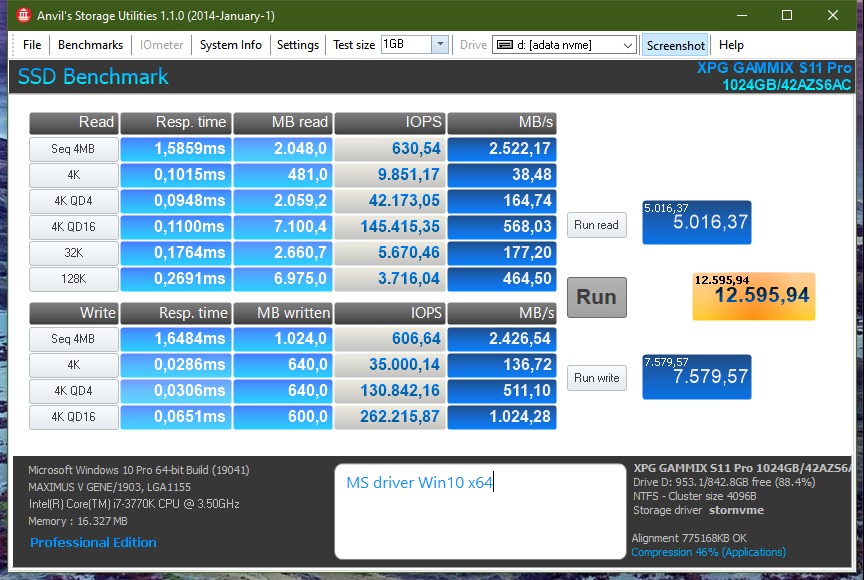
MS
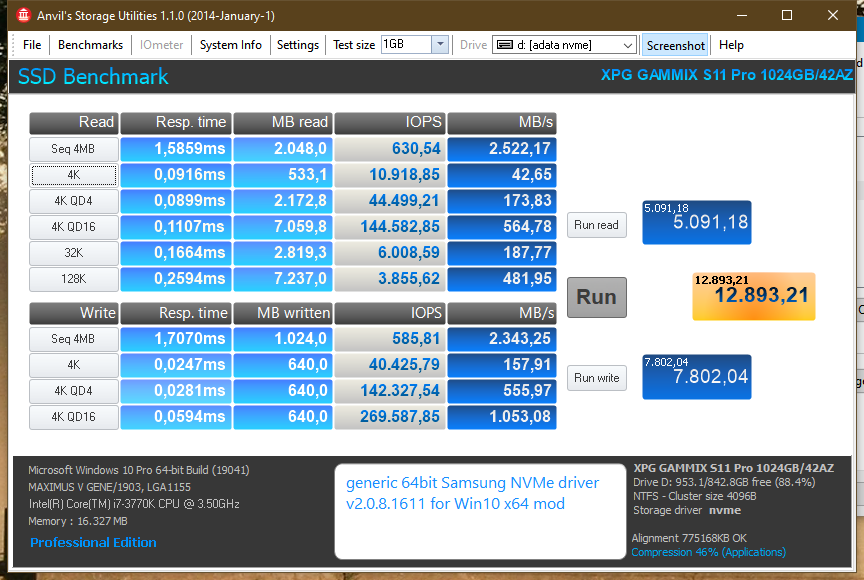
2.0.8.1611 mod
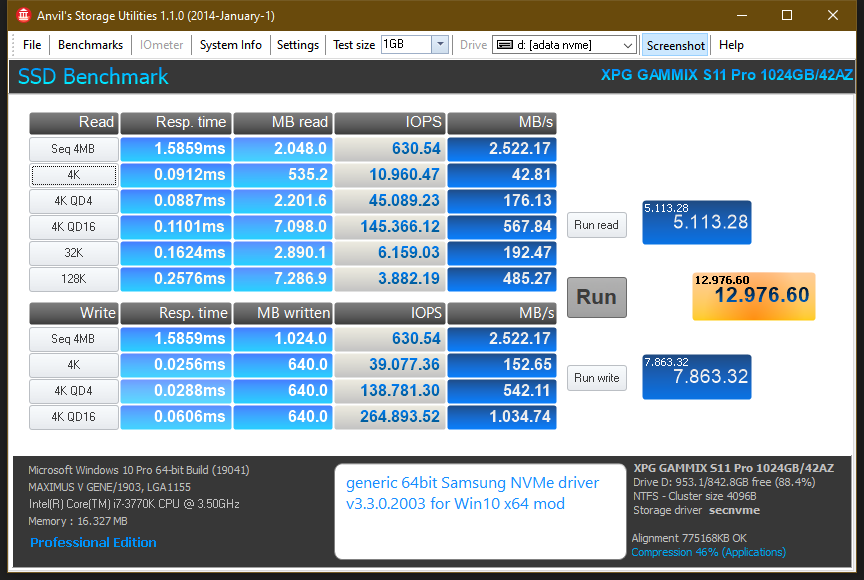
3.3.0.2003 mod
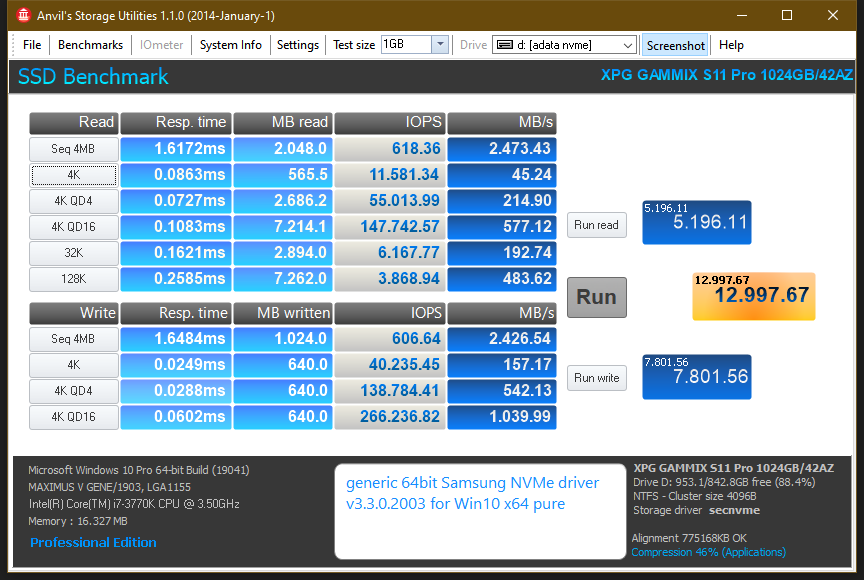
3.3.0.2003 pure
Basically all the 3 Samsung drivers are the same, and the default MS one is inferior in writes for the 4K parts.
And just ignore the higher 4K QD4 in the 3.3.0.2003 pure read test, it happened only then, a fluke…
sorry how to download nvme drivers please?
@tasosko :
Welcome to the Win-RAID Form!
By doing a double-click onto the related download link. You can find the links within the first 2 posts of >this< thread.
Regards
Dieter (alias Fernando)
Hello, a search has brought me to this great article, may be someone has an idea how I fix my issue. Coincidently after installing a new GraphicCard (I assume has nothing to do with the problem, other than triggering a major driver update) my 2 Sabrent Rocket 4.0 now perform really bad (below 3%tile bad) in small file performance - large sequential files are still fast. My Older Samsung 960Pro still performes blasingly fast. I assume the Sabrent drives somehow switched to a slow driver - but how do I identify what driver they are running on given the Samsung Driver does reside on my system happily to support the 960Pro ? Attached the StorageController section from Device manager on whats shown there. Thanks ahead of time to anyone who can help.
Cheers
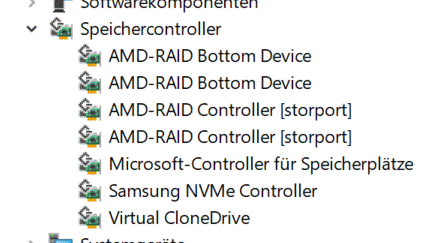
@verandy :
Welcome to the Win-RAID Forum!
If you want to know, which NVMe driver the NVMe Controllers of your Samsung SSD and your AMD RAID array are using, you have to do a right click onto the related devices, which are listed within the "Storage Controllers" section of the Device Manager, and choose the options "Properties" > "Driver" (> "Driver Details").
Contrary to you I suspect, that the insertion of the discrete graphics card has something to do with the performance of your NVMe SSDs (not enough bandwidth due to less available PCIe lanes?).
Please give us some additional information about your system (mainboard, chipset, CPU).
Happy Easter!
Dieter (alias Fernando)
Hi,
Thanks for the fast response - some quick info on the system: Ryzen 3900X on Gigabyte Xtreme X570 with 16GB Memory
The lane Bandwith should not be the problem - both Rockets are direct to CPU - one in primary M2 one on extension card in PCIE Slot 2 - the way the bord is documented that should drive the primary slot for the GPU to 8X - the secondary also to 8X with only 4X used by the Rocket and finally the M2A having its own 4x lanes - the now much faster Samsung is in M2B Slot which is supported by the Chipset and hence should be the slow one.
The problem with identifying drivers is that only the Smasung shows as an NVMe storage controller, the others show as AMD-RAID Bottom Device and AMD-RAID Controller (storport) - however RAID has never been enabled in BIOS - not for SATA and not for NVME - another strange thing is that in HWINFO the Samsung shows as NVME with a green Checkmark the rockets show as "ATA AMD-RAID Sabrent Rocket 4 " without checkmark.
Something strange has happened here - I can not specifically pin down when it first appeared like this since it was the new Graphics Card triggering running benchmark - system as such behaved normally under light load use the last 2 weeks. But 3 weeks ago on the same set-up (other than GPU) the Rockets had a Userbenchscore setting a new 100%tile and now they are more or less on SATA level other than sequential write is far beyond max SATA bandwith. Somewhat lost what to try.
Cheers & also Happy Easter & Stay Healthy
EDIT:
PS: another strange symptom is that I can not activate Write Cache for the Rockets, while it works fine for the Samsung
All good now - I just forced the recomended Samsung Driver on the Rockets (and the today newly installed 905P 380 GB - which also configured first as an AMD - RAID even though in BIOS it is not even shown under NVMe Drives burt has its own storage class section) - full performance on all drives now - HWInfo also shows the drives as they should be - still no idea why Windows installed these crippling drivers - if it happens again I know where to look. Thanks a lot for this thread here, spared many frustrating days ! Pictures attached

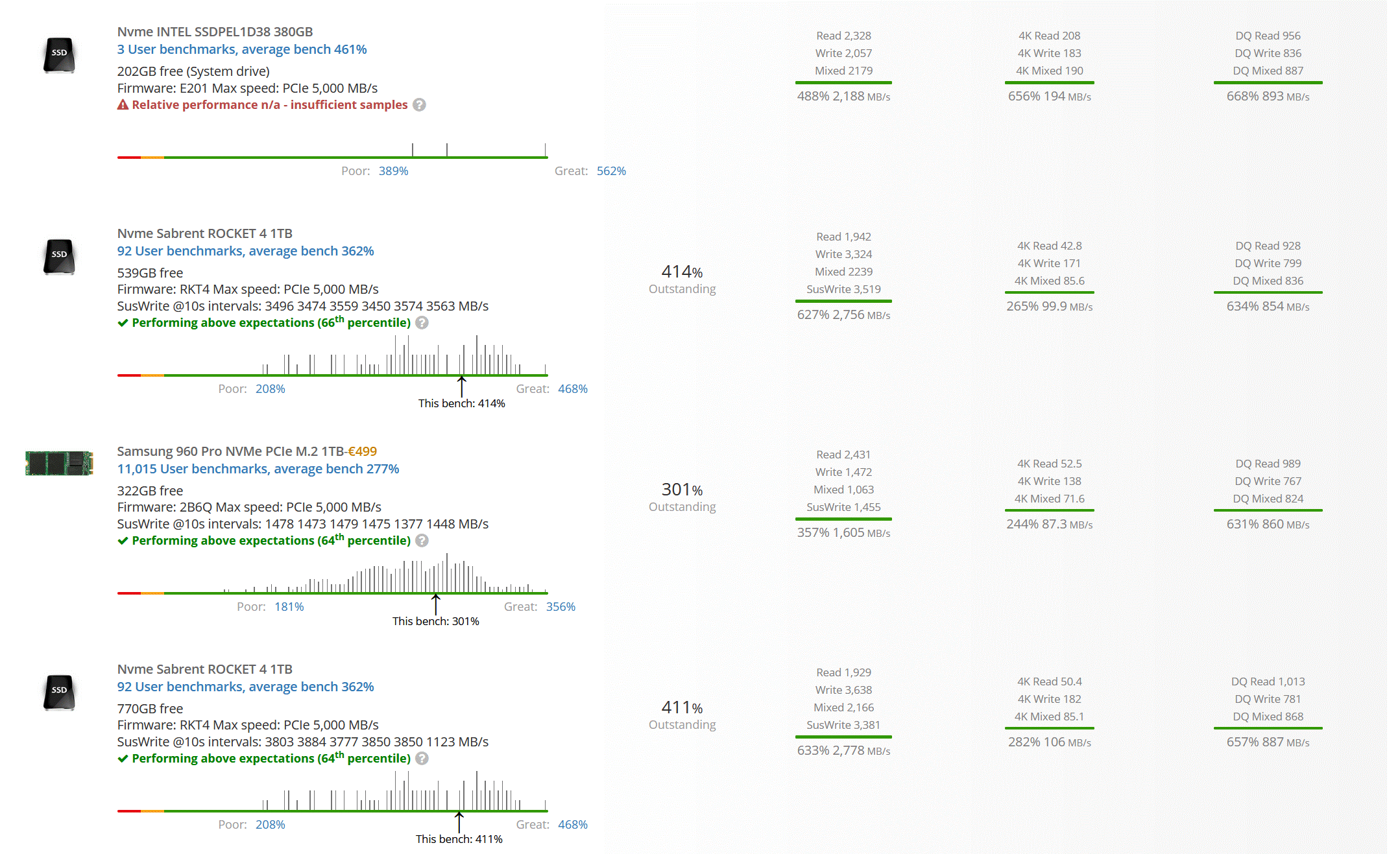
Cheers
@verandy :
Thanks for your report. It is fine, that you were able to solve the performance problems of your Sabrent Rocket 4.0 SSDs.
Since I doubt, that the Windows Update had replaced by its own the MS in-box NVMe driver by the AMD RAID ones, I suspect, that it was you yourself, who installed the AMD RAID drivers by an oversight.
Additional questions:
1. Which specific Samsung NVMe driver did you install for the NVMe Controllers of the Sabrent SSDs and how did you install it?
2. Do you use the Sabrent Rocket Control Panel? If yes, can you search for an update of the Firmware and the Control Panel software?
Happy Easter as well!
Dieter